There’s no need to explain the Toyota Land Cruiser, one of Toyota’s earliest successful products. The 2020 Toyota Land Cruiser Heritage Edition celebrates some 60 years of popularity of a vehicle that has survived the segment’s “mall wagon” phase and the rise of crossovers. Its already-sterling reputation has received an additional recent push from the rise of overlanding — an outdoor pastime that has always existed but only recently got a press agent.
By comparison, the Lexus LX is a more recent development. Debuting in 1996, the LX 450 was little more than an 80-series Land Cruiser with cladding, a Lexus badge and a higher price. The amount of styling differentiation and luxury specialization has increased over the years to the point that the newest LX 570 actually seems like a completely different vehicle.
In truth, the 2020 Lexus LX 570 and the 2020 Toyota Land Cruiser are both 200-series Land Cruisers under the skin. They share the same thirsty 5.7-liter V8 engine and the same frame that features a double-wishbone suspension at the front, a five-link coil spring suspension at the rear and a 112.2-inch wheelbase in the middle. The styling is strikingly different, of course, but so are the hidden details of their suspensions.
The Land Cruiser employs a simple set of coil springs and shock absorbers, but with an interconnected pair of automatically disconnecting stabilizer bars called KDSS (Kinetic Dynamic Suspension System). The Lexus, on the other hand, has fixed stabilizer bars and coil springs, but its “shocks” are really hydraulic cylinders that perform height adjustments and transmit suspension movements via piping to remote electronically-adjustable damper valves mounted along the frame rails.
All of the above begs a question: Which of them will go farther up my RTI ramp and, by extension, offer better suspension articulation in an authentic off-road situation?

Right away, the very approach to the ramp demonstrates a huge difference and a serious issue for the LX. Its normal cruising height (there is a lower height, but this isn’t that) doesn’t provide enough approach clearance to attempt the ramp. The front spoiler contacts the nasty grating before the tire does. It’s a close-run thing, but from this point on, clearance gets SMALLER as the left front suspension compresses on the way up. If it's touching now, it’s only going to get worse if I go forward.
It must be noted that this LX570 test sample is fitted with the optional “Sport Package” that consists of, among other things, an even more aggressively-styled front fascia with built in “spoilers” that do a fantastic job of living up to the primary definition of the word by ruining approach clearance directly in front of the tires. Things surely would have been different if this LX 570 lacked this $2,510 appearance package.
But our LX 570 isn’t out of this fight yet. Its four-wheel height control system includes a switch that raises the front 2 inches and the rear 2.4 inches. That’s more than enough to give it the clearance it needs to drive up the ramp. But I discovered a problem when I pressed the switch to put it in high mode: The system raises the rear axle first, which has the effect of driving the barely-touching nose firmly into the ramp. The front doesn’t begin to rise until after the rear is fully raised. This seems backwards. You approach obstacles at the front, so the front should lift first.
Meanwhile, the Land Cruiser, which only has one fixed height, has no trouble motoring right on up the ramp.
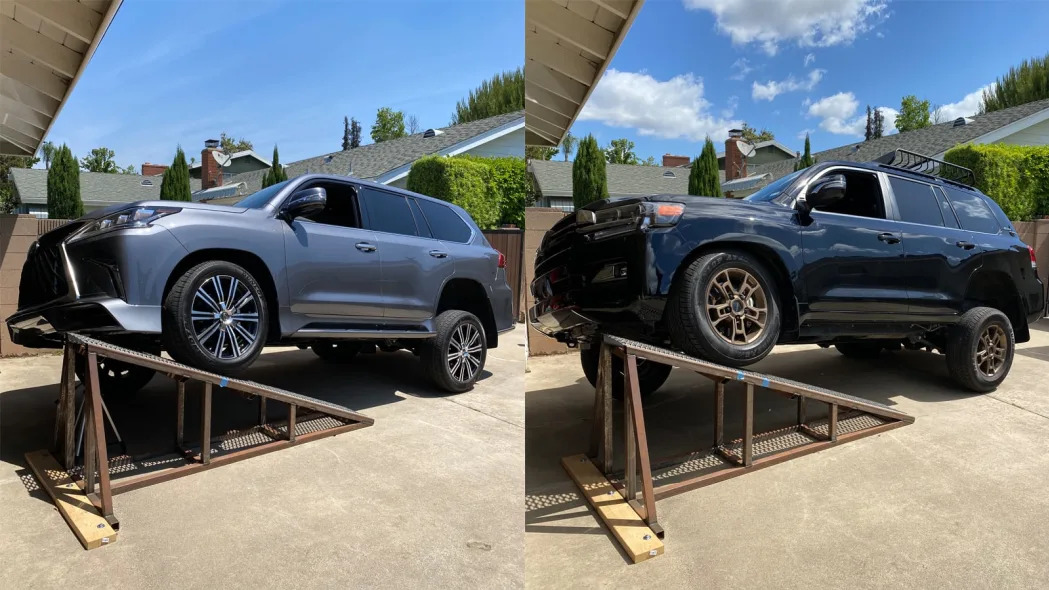
The Land Cruiser’s advantage is clear. It is able to drive about 8 inches farther up the ramp than the LX before the left-rear tires of both vehicles lose contact with my driveway and start spinning.
Such a visual comparison isn’t always meaningful when different makes and models compete for honors on the ramp, but it works here because they have precisely the same wheelbase.
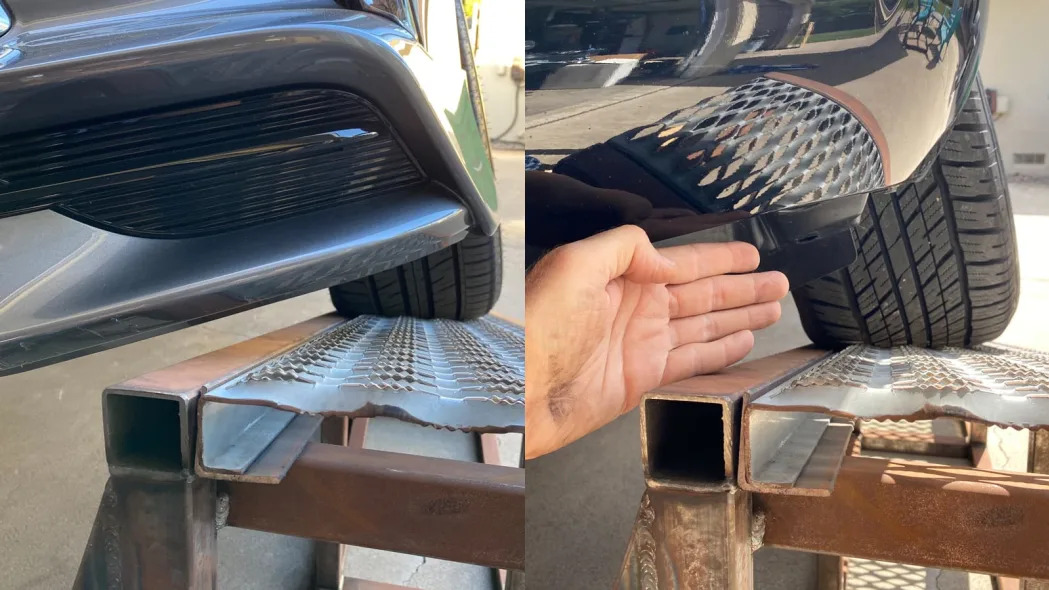
Even when set to high mode, the LX is still in worse shape at the top of the ramp than the Land Cruiser. I can barely swipe my index finger through the gap, and only if flat; it won’t fit sideways. This reaffirms my decision to award zero points to the LX in normal mode because the vehicle would drop 2 inches and crush its front bodywork if I were to engage it now.
Meanwhile, the Land Cruiser’s front fascia stands high enough that I can fit my whole hand in there with room to spare. I’m not worried about the flap in the background because it is flexible enough to move out of the way. It’s also a hidden unpainted piece that sits farther back.
This comparison illustrates that the LX's spoiler isn’t just harming the approach angle because it’s lower, it’s also causing difficulty because it juts farther forward. The spoiler is about the same distance from the camera even though the LX’s tire (and its general bulk) are some 8 inches farther away down the ramp.
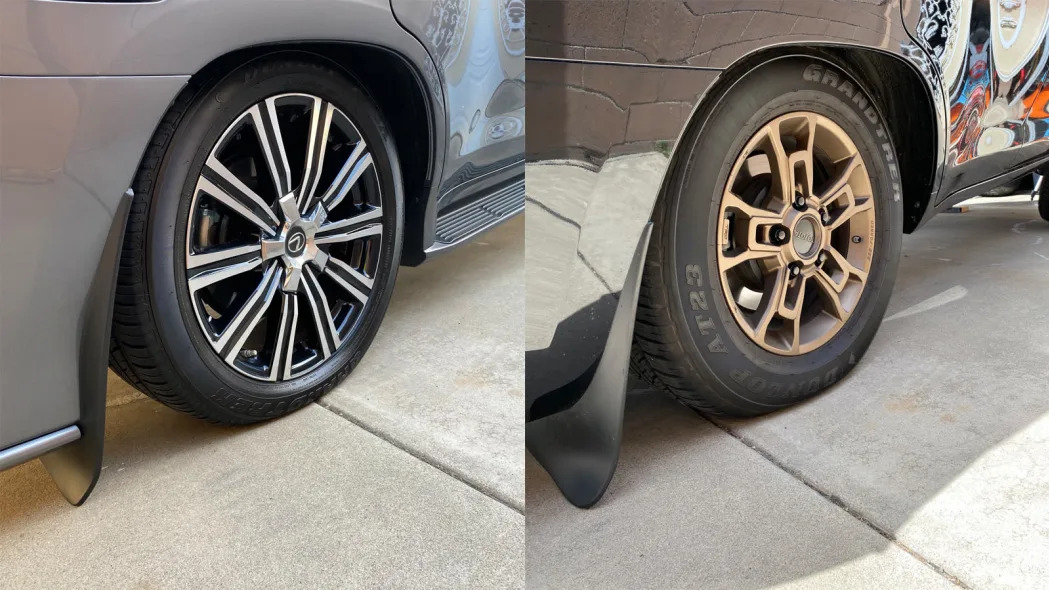
The opposite corner — passenger side rear — is at full compression, with both suspensions resting on their bump stops. There doesn’t seem to be much of a difference in flex back here.
That said, a small difference is apparent if I put my fingers in above the tire. I can fit three in the LX, but I have to bend one back to do the same in the Land Cruiser. Call it 2 1/2 or 2 3/4. Both tires are said to have the same overall rolling diameter, but the Land Cruiser’s sidewalls are 1.5 inches taller. They’ll compress more at the bottom, so I suppose they could likewise distort upward at the top a small amount.
Lower down, the seam in my driveway and the warp in the mudflaps further illustrates how much farther the Land Cruiser was able to climb and pitch its nose up.
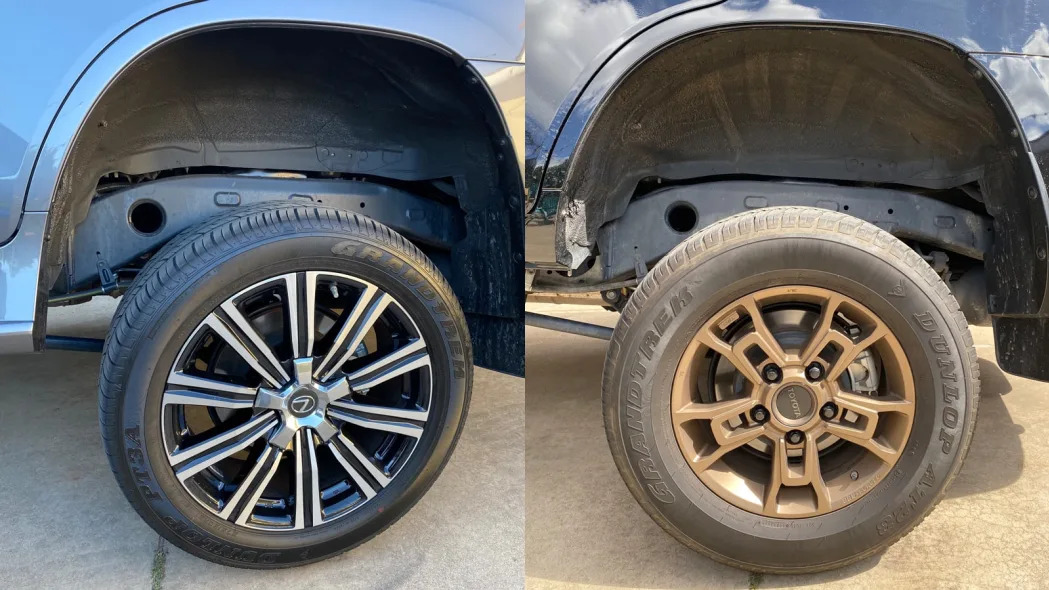
The amount of flex looks to be quite similar from this side, too. But the tires really stand out here. The LX 570 comes standard with 20-inch wheels and tires, but this one has the optional 21-inch upgrade. The term upgrade is debatable on a whole host of fronts, but it's a clear negative when it comes to off-highway performance. The Land Cruiser, on the other hand, rides on 18-inch wheels and tires that make much more sense off road. The Heritage Edition comes with special BBS forged wheels that are lighter than the standard Land Cruiser 18-inch fitment.
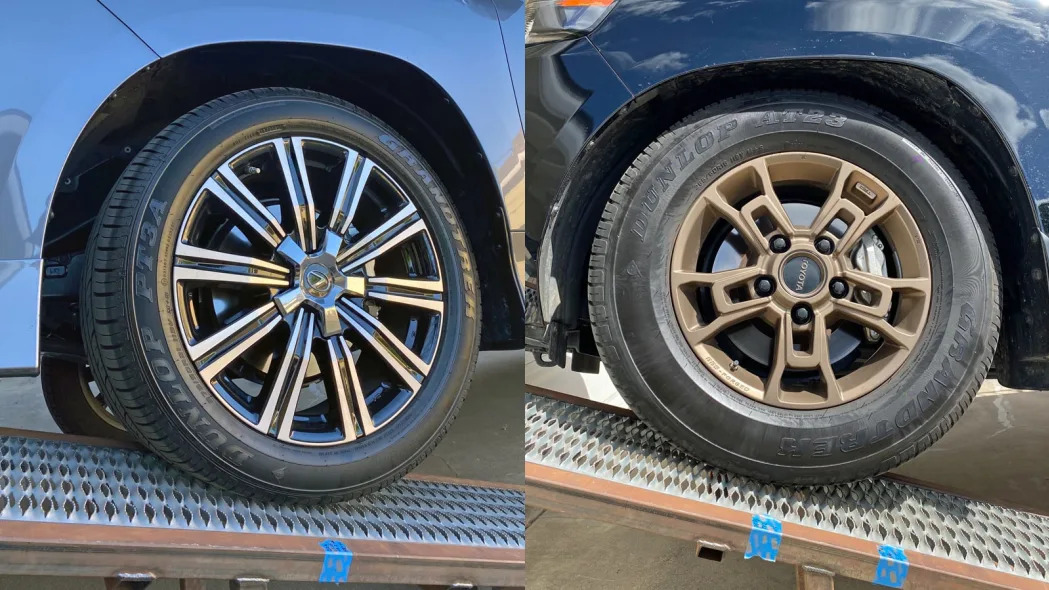
The difference in suspension flexibility is most apparent up front, where the Land Cruiser’s front tire tucks much farther up into the wheel well. This extra flex is why it can drive farther up the ramp, as evidenced by my two pieces of blue tape. The Land Cruiser’s disconnectable KDSS stabilizer bars may deserve credit here, but I’m not able to confirm that because I couldn’t drive the LX 570 up the ramp in its normal height mode to make a direct comparison.
Why does this Hi mode matter to this measurement? Height-adjustable suspensions typically articulate more in normal height mode than they do in any raised mode. The mechanism that makes the vehicle rise does so by making the suspension stiffer, which lessens the amount of suspension compression for a given level of force. The LX’s front tire would almost certainly compress farther up into the fender in normal mode and climb higher up the ramp, but there isn’t enough approach clearance to attempt that measurement.
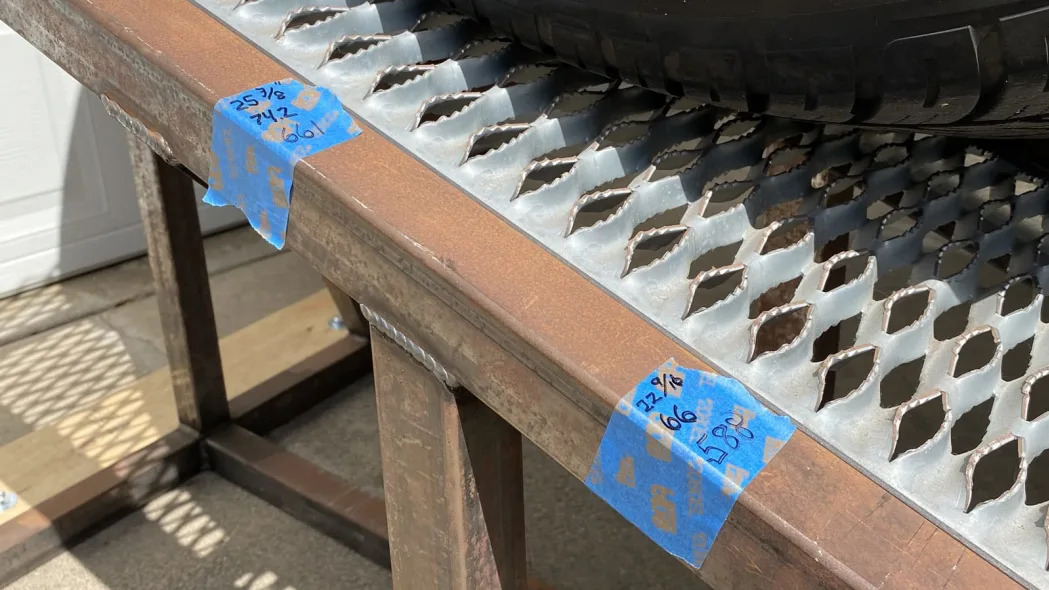
Here’s what all of this boils down to in terms of Ramp Travel Index, which is the distance a vehicle climbs up the ramp divided by its wheelbase — multiplied by 1,000 to remove any pesky decimals and make things more interesting.
Here are the results:
LX 570, normal mode: 0 inches of climb ÷ 112.2 x 1,000 = 0 points
LX 570, high mode: 66 inches of climb ÷ 112.2 x 1,000 = 588 points
Land Cruiser: 74.2 inches of climb ÷ 112.2 x 1,000 = 661 points
Conclusions:
First, the Land Cruiser is very capable right out of the box; 661 points is no joke. That’s more than a Gladiator Rubicon can manage with its stabilizer bar disconnected. Also, the LX 570’s high mode score of 588 points is still impressive in its own right. A TRD Tacoma can’t manage 500 points, if you need a reference point.
But the LX’s so-called Sport Package absolutely ruins the approach angle in normal mode, and it’s barely passable even in high mode. Do not get the Sport Package if you’re eyeing the LX 570 for any sort of off-pavement touring.
It’s hard to know what the lack of the Sport Package would mean to the LX. The extra chin clearance would certainly allow it to make a ramp attempt in normal mode, and it would certainly score higher. Would it be enough to match the Land Cruiser? It’s hard to say, but 661 points is only 8.2 inches away. It is the same chassis, so it might manage it if the fixed stabilizer bars don’t get in the way.
I’d love to conduct that test, but I can already tell I wouldn’t bother with the LX 570 if I had overlanding in mind. Its adaptive variable suspension and street-focused wheel and tire package are there to please pavement cruisers, and the sheer complexity of the system makes it impossible to install a spring and shock upgrade without ripping it all out and dealing with the blinking warning lights that would inevitably mark its absence.
The answer is right there in the name: if you want to get out there and cruise on some land, get the Toyota Land Cruiser.
Related Video:
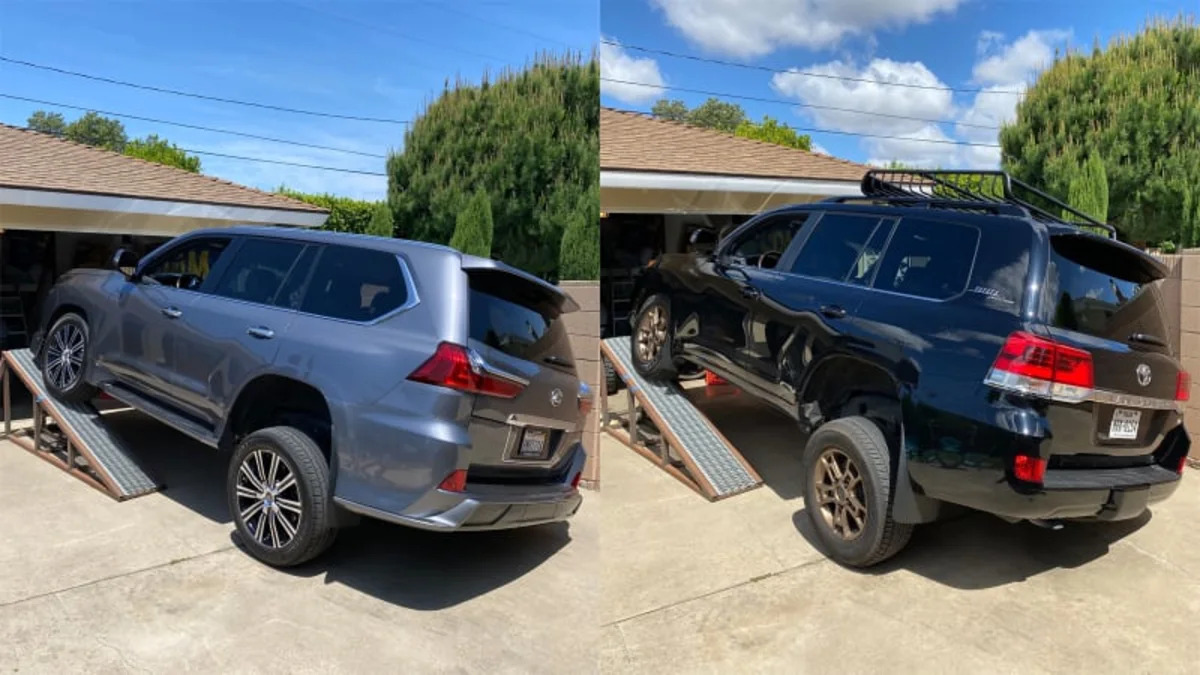

Sign in to post
Please sign in to leave a comment.
Continue